Utah PLSS Quarter Sections GCDB
Last update · April 8, 2022
Quarter section data is commonly an aliquot part of a section 160 acres in size. Sections are divided by running straight lines from the fixed quarter section corners to the opposite corresponding quarter section corners, thus creating quarters of a section and defining the center of the section.
Use the data
Explore and Download
Utah PLSS Quarter Sections GCDB , opens in a new tab in the SGID on ArcGIS Utah PLSS Quarter Sections GCDB feature service , opens in a new tabQuick clips
Feature service URL
https://services1.arcgis.com/99lidPhWCzftIe9K/ArcGIS/rest/services/UtahPLSSQuarterSections_GCDB/FeatureServer/0 Open SGID sample query
select * from cadastre.plss_quarter_sections_gcdb limit 10; Getting started
Tip
A closer look
PLSS Quarter Sections GCDB is a polygon dataset. This data is derived from the PLSSIntersected feature class of the Utah PLSS Fabric GIS version 2.3 2020. This layer is based on Geographic Coordinate Data Base (GCDB) coordinate data. The locations of Public Land Survey System (PLSS) corners, as represented in geographic coordinate pairs, were derived from a variety of source documents, which include U.S. General Land Office and BLM survey plats/notes, as well as survey data obtained from other U.S. Government agencies, private sector survey firms, and local governments. The attributes assigned to PLSS polygons were taken from the BLM's Legal Land Description (LLD) data set, contained within the Legacy Rehost for the year 2000 (LR2000) automated records system. The coordinate data was produced by using control stations of known location, with varying degrees of accuracy, from various sources which include but are not limited to; U.S. Geological Survey (USGS) topological quadrangles and other sources, National Geodetic Survey (NGS) and US Coast & Geodetic Survey (USC&GS) Cooperative Base Network (CBN) control, Federal Base Network control (FBN), and Continuous Operating Reference Stations (CORS), and Global Positioning System (GPS) data, which is then analyzed and adjusted in concert with official survey data for any given geographic area. This data is a useful representation of the geometry and topology of parcels contained within the PLSS, but its application is intended for mapping purposes only. The GCDB data is not a substitute for a legal land survey.
The native spatial reference for this dataset is UTM Zone 12N, NAD83 (0.01 meter x,y coordinate precision; 0.001 mile m coordinate precision). There are no constraints or warranties with regard to the use of this dataset. Users are encouraged to attribute content to UGRC. This statewide dataset is maintained by UGRC for navigation purposes and because of user's request. The geographic coordinates and their associated products are NOT legal land survey records. The coordinates can NOT be used as a substitute for a legal land survey. They can be used for record keeping, mapping, graphics and planning purposes only. No warranty is made by the Bureau of Land Management for use of the data for purposes not intended by BLM.
The Quarter Sections are no longer a standard and is now published as a Reference layer by the UGRC. This data is derived from the Intersected layer of the CadNSDI published version of the PLSS, which includes quarter-quarter, sixteenth or government lot division, mineral surveys, and many Unsurveyed areas of the PLSS. Many areas will not have a designated location (NE, NW, SW, SE) in the original data so will not be classified in the Quarter Sections layer. This data is from the Utah PLSS Fabric Version 2.3 2020 of the Utah GCDB.
Quarter Sections were consolidated from the Quarter Quarter Sections to better represent the four quarters in all Aliquot Part areas. Areas with Lots or Special Surveys remain as is. Updated 4/8/2022
Update history
- April 8, 2022
- December 15, 2020
- October 15, 2019
- January 15, 2019
- January 1, 2018
- November 1, 2016
- August 28, 2015
PLSS at a glance
Example Description: A parcel of land situated in the south half of the southeast quarter of the northeast quarter of Section 31, Township 2 South, Range 2 West, Salt Lake Base and Meridian.

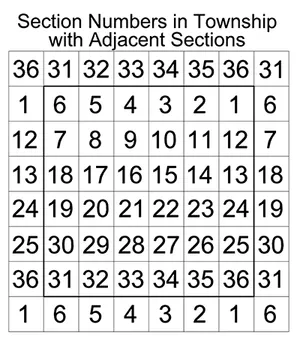
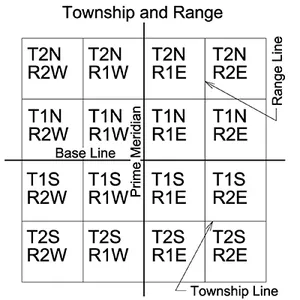
Township and range explained
(5 characters each)
- 3 digits for Township or Range number
- 1 digit for fraction (0 for no fraction, 1 for 1/4 township, 2 for 1/2 township, 3 for 3/4 township)
- 1 letter for direction
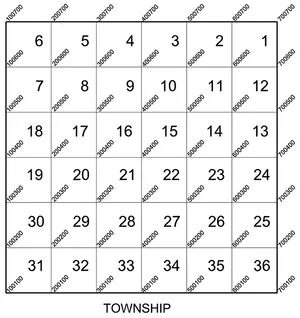
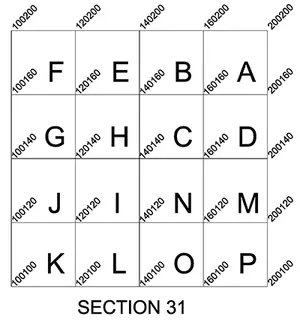
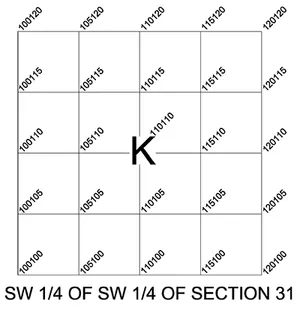
Geographic Coordinate Data Base (GCDB) is explained
Bureau of Land
Management (BLM)
Point IDs

GCDB Point ID
This 6 digit number is the combination of two three letter sequences - XxxYyy.
- The first 3 digits (Xxx)
-
Xxx - may be the same for all points in a similar survey.
- 711 - 719 Town Sites, City Boundaries
- 720 - 739 County Boundaries
- 740 - 769 State Boundaries
- 770 - 799 Forest Service, Parks Service, Reservations,
- Grant, Other Boundaries with Mileposts.
- 800 - 836 Meanders (right bank even #, left bank odd #.)
- 837 - 879 Tracts
- 880 - 899 Right of Ways
- 900 - 999 Mineral Surveys, Homestead Entries, etc.
- The last 3 digits (Yyy)
-
Yyy - Numbered sequentially along the survey in increments of 10. The prefix
- Irregularities of Townships for the first index of [X]xx and [Y]yy
-
1, 2, 8 or 9 → offset corners along interior section lines and section subdivision lines where +/- 2 is the recommended naming scheme.
3 or 7 → offset corners along township boundaries, angle points, witness corners, and witness points.
4 or 6 → intersections of rectangular/special surveys and 1/16th corners of elongated sections.
0 → all regular aliquot corners down to 1/16th.
5 → all regular aliquot corners down to 1/256th.
Common conversions
Distance Conversions
- 1 Mile
-
- → 80 chains
- → 320 rods
- → 320 perches
- → 320 poles
- → 5,280 feet
- → 8,000 links
- → 1,609.2655 meters
- 1 Chain
-
- → 4 rods
- → 4 perches
- → 4 poles
- → 66 feet
- → 100 links
- → 20.1168 meters
- 1 inch
-
- → 0.0254 meters
- 1 Link
-
- → 0.66 feet
- → 7.92 inches
- → 0.2017 meters
- 1 Meter
-
- → 39.370 inches
- → 3.281 feet
- 1 Rod
-
- → 16.5 feet
- 1 Perch
-
- → 25 links
- 1 Pole
-
- → 5.0292 meters
- 1 Foot
-
- → 0.3048 meters
Area Conversions
- 1 Sq. Mile
-
- → Nominal Section
- → 640 acres
- → 2.590 sq. km.
- → 259 hectares
- 1 Acre
-
- → 10 sq. chains
- → 160 sq. rods
- → 160 perches
- → 160 poles
- → 43,560 sq. feet
- → 0.4047 hectare
- → 4,047 sq. meters
- 1 Hectare
-
- → 2.47 acres
- 1 Sq. Meter
-
- → 10.764 sq. ft.